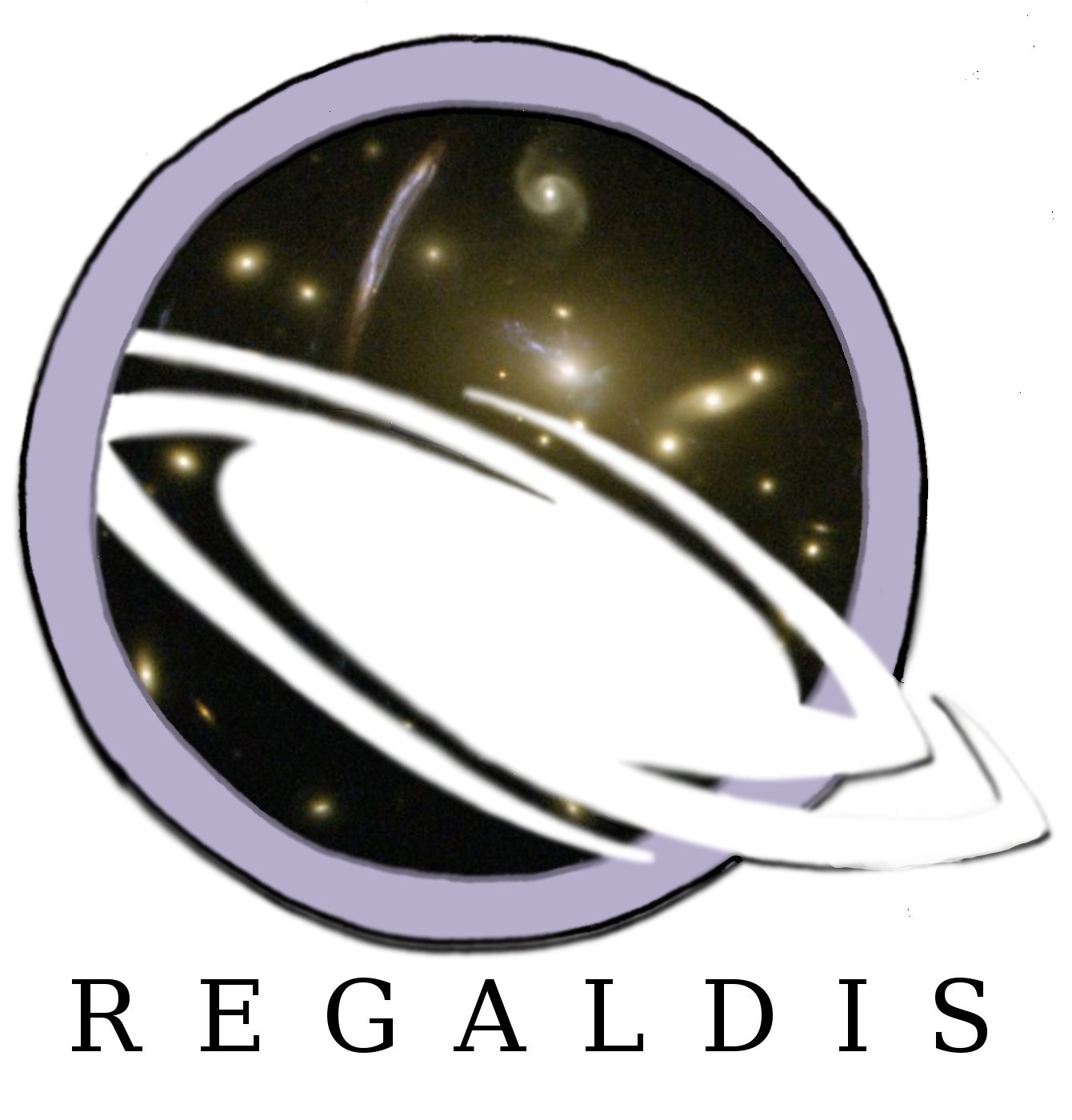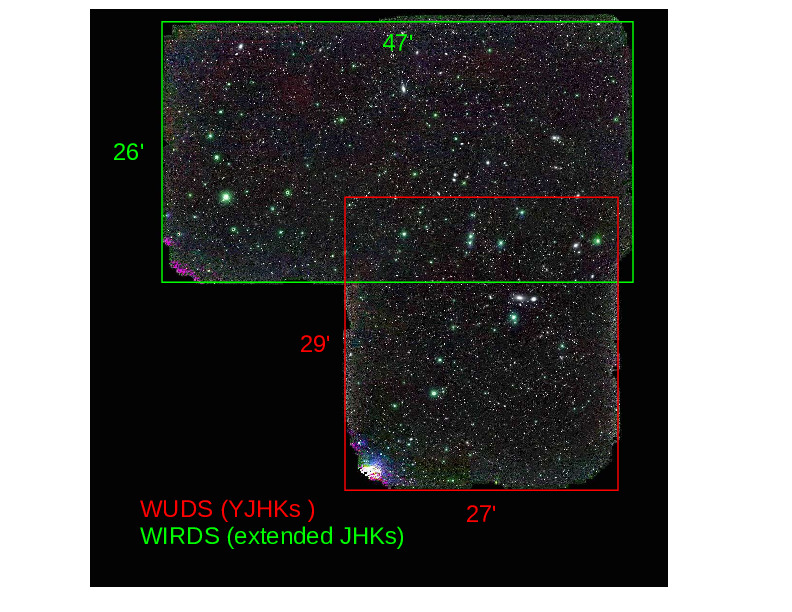
The WIRCam Ultra Deep Survey (WUDS)
 |
The WIRCam Ultra Deep Survey (WUDS) |
 |
WUDS Overview The WIRCam Ultra Deep Survey (WUDS) is a near-IR photometric survey carried out at the CFH Telescope in the field of the CFHTLS-D3 field (Groth Strip). WUDS includes four near-IR bands (Y, J, H and Ks) over a field of view of ~400 arcmin^2. The area and depth of this survey were specifically tailored to set strong constraints on the cosmic Star Formation Rate and the Luminosity Function brighter or around L* in the z~6-10 redshift domain, although these data are also useful for a variety of extragalactic projects. WUDS is intended to provide a robust database in the near-IR for the selection of targets for detailed spectroscopic studies, in particular for the EMIR/GTC GOYA Survey. |
|
WUDS Observations and data processing Observations were carried out with WIRCam at the Canada France Hawaii Telescope. WIRCam is a wide-field near-IR camera with four HAWAII2-RG detectors, 2048x2048 pixels each, and a pixel scale of 0.306 arcsec. The total WIRCam field of view is 21.5 arcmin x 21.5 arcmin, with a gap of 45 arcsec between adjacent detectors. |
|
|
WUDS was carried out on a field centered around AR=14:18:15.3 DEC=+52:38:45 (J2000), in order to avoid the presence of bright stars while maximizing the coverage by other surveys, in particular the DEEP Groth Strip Survey and the AEGIS Survey . The WUDS pointing was chosen in such a way that observations could be combined with public CFHTLS-Deep data on this field, obtained through five bands in the optical domain, namely u*, g, r, i, and z. WUDS images were obtained in queue scheduling mode between May and July 2008, in the four broad-band filters of WIRCam, namely Y, J, H and Ks, in a single shot with WIRCam, with nodding and dithering configurations allowing us to maximize the area covered with more than 75% of the total exposure time over the WIRCam field. In addition to these observations, 16.6h of exposure time on the same area were added, obtained by the WIRDS Survey in J, H and Ks. Table 1 summarizes these observations, referenced as ``WUDS'' in this Table, also corresponding to the area delimited in red in Figure above. In order to obtain well sampled images given the goal seeing conditions, and to achieve an optimum matching with the CFHTLS-D3 images, on-target observations were performed using the micro-dithering pattern of WIRCam. This consists of a 2x2 dithering pattern with offset positions separated by 0.5 pixels, constituting a ``data-cube''. Each data-cube in Tab.2 contains four such images. Observations were performed with large dithering patterns (the equivalent of 1/2 of detector, the four detectors being separated by 45 arcsec; see above) and large overlaps providing an optimized gap filling and also a better object removal for sky-subtraction.
Data processing was performed at CFHT (preprocessing phase) and
Terapix/IAP (advanced processing). A two-step approach was adopted for
sky-subtraction and image stacking. The main steps are the following:
Astrometric calibration was performed with SCAMP . The accuracy of internal astrometry ranges between 0.02 and 0.035 arcsec at 1 sigma level for all filters. Final images were combined using the weighting scheme given above, using a sigma-clipped mean with a 3 sigma rejection threshold. The final stacks were matched to the CFHTLS-D3 T0006 images and pixel scale (0.186 arcsec). The accuracy of astrometry is typically 0.05 arcsec, with a systematic offset of less than 0.005 arcsec. Regarding the accuracy achieved in the determination of ZPs, it ranges from 0.021 to 0.023 magnitudes in J, H and Ks bands in the WUDS survey alone (it is between 0.03 and 0.04 when combining WUDS and WIRDS data on the whole field). It is 0.067 magnitudes in the Y-band for WUDS (0.075 for WUDS $+$ WIRDS) due to indirect recalibration. These estimates are based the comparison between individual detections of several 10^4 stars in each band. |
|
|
WUDS Catalogs
To built the final catalogs, WUDS data were combined with public
CFHTLS-Deep data on this field, obtained through five bands in the
optical domain. The WUDS catalogs include nine filter bands with full wavelength
coverage between ~0.35 and 2.3 microns. 3 catalogs were built for the needs of
WUDS main science, two near-IR-selected catalogs and a catalog based on the i+z detection image
as follows :
All these catalogs can be found, together with the images, following the Donlowd Section below. Sources were detected with the SExtractor package version 2.8. Extraction was performed using a very low detection threshold of 0.8 sigma (SExtractor definition) for a minimum number of 4 pixels above the threshold, in order to optimize the detection of compact and faint sources. A background mesh of 64 pixels was used for background subtraction. Magnitudes and fluxes were measured in all images with the ``double-image'' using the corresponding detection images. Total magnitudes and fluxes were computed based on SExtractor MAG_AUTO magnitudes. Also aperture magnitudes were derived within 14 different apertures ranging from 1.3 to 5 arcsec diameter, on the original images, and also on images matched to the u*-band seeing using a simple Gaussian convolution. Photometric errors were measured using the typical background variance of the original images (without any seeing matching or rescaling), within apertures of the same physical size as for flux measurements (either aperture or MAG_AUTO magnitudes). Errors in colors were derived by quadratically adding the corresponding errors in magnitude. Details can be found in Paper I (see references below). |
 |
|